News & Articles
Browse all content by date.
At the city council’s agenda session of February 9, 2017, an item on the consent agenda authorized a $50,000 agreement between the city and Pyrotechnic Display, Inc. for a fireworks show this Fourth of July. The money was slated to come from a tourism tax revenue fund. Director of public administration Jim Filby Williams explained to councilors that the contract was similar to contracts of years past—it was the “same vendor, same scope of work. The only difference is that the city of Duluth is managing and administering the contract rather than Visit Duluth.”
That was a pretty big difference. Visit Duluth, the nonprofit tourism bureau that carries out marketing and promotional activities for the city, has sponsored the fireworks show for more than twenty years, promoting it as the biggest show in the state. “People’s expectations grow greater every year, so we’re always trying to raise the bar,” then-president of Visit Duluth Terry Mattson told a reporter in 2008.
But no more, apparently. When I called Visit Duluth president Anna Tanski, she told me that Visit Duluth was trying to limit their direct participation in events in order to focus more diligently on their core mission of promoting the city. The fireworks, though popular, took up resources that she felt could be better used elsewhere.
“We’re a very small staff [Visit Duluth has 13 employees. --JR], and it’s a one-day event that draws significant resources in order to cater that, and then we’re responsible for cleaning up the following day. So we literally take our team of people out there and put on our rubber gloves and pick up all the debris and clean up the launch site. It just takes an incredible amount of time and we really felt the city had more resources available, either through public works or the parks and recreation department, and it was a better fit for them to be able to take on that responsibility, and it then gave us additional resources to put towards marketing.”
The fireworks are only the latest event from which Visit Duluth has disengaged. Since taking over in 2014, Tanski has managed Visit Duluth’s strategic withdrawal from two other events as well.
The first event was Snocross, a professional snowmobile racing event that Visit Duluth co-sponsored with Spirit Mountain for years. Tanski told me that sometimes they made money on Snocross and sometimes they didn’t, but it was “a significant, time-consuming event over a major holiday weekend for our small team of people.” In 2014, they withdrew from the event. “We totally were agreeable to walking away from that and letting Spirit Mountain enjoy the full benefit of hosting that.” There are also risks to hosting Snocross, but so far the updated arrangement seems to be working well for Spirit Mountain, bringing the ski hill increased revenues in 2015 and 2016.
The second event was Tall Ships. Tanski told me that when Visit Duluth sponsored Tall Ships in 2013, it was “wildly successful” at drawing people to Duluth, but that they still ended up losing about $80,000 on the venture. “We considered [that] really just the cost of doing business, and the cost of marketing to get that many people in town and filling hotel rooms and restaurants, but we couldn’t continue.” They turned the event over to a private promoter, who put it on in 2016 with the notable addition of a giant rubber ducky. Tanski said Visit Duluth did not participate in the 2016 Tall Ships at all, except to “offer marketing support like we do for all of the major events.”
“Our role is marketing,” Tanski said. “That is what we exist for, to market events, to bring the maximum number of visitors to town to attend those events, and that’s what we’re really good at...It just was the perfect opportunity for us to market the event but not be responsible for putting on the event.”
The cherry on top
Though not a part of the government, Visit Duluth receives the bulk of their funding from the city’s tourism taxes; as the taxes have grown over the years, so has Visit Duluth’s budget. In 2017, the city expects to collect about $12 million in tourism taxes. Visit Duluth’s share, which they negotiate with the city, is $1.9 million. This is a $100,000 increase over 2016. The city’s resolution approving the increase explains that the extra money will allow Visit Duluth “to expand marketing to retirees, international markets and sports venues in the Twin Cities.”
There’s no question that Visit Duluth is doing their job—tourism has grown almost uninterrupted in the city for thirty years. But it should also be noted that by taking over the fireworks, the city is essentially giving Visit Duluth a $50,000 cherry on top of their $100,000 budget increase—not a bad boost for one year. We should expect to see some truly spectacular promotion.
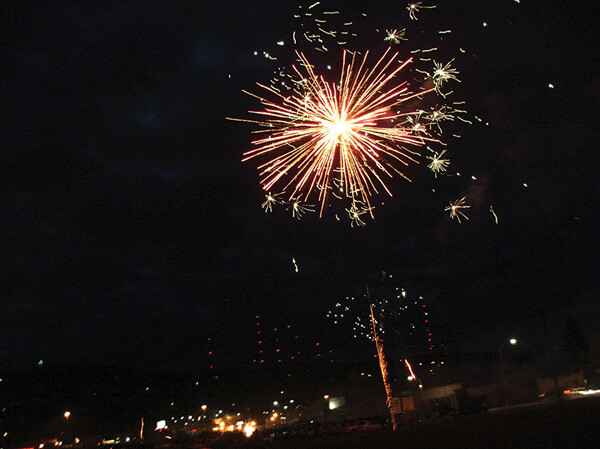
The narrowly averted fireworks cancellation fiasco of 2004
Visit Duluth’s 400-plus members are very protective of their budget and priorities, and in general the city is protective of Visit Duluth. On one occasion, however, thirteen years ago, the city council tried to take $200,000 from Visit Duluth’s budget and use it to fund three firefighter positions. The response of the tourism community was immediate and indignant, with email flooding councilors’ in-boxes and spokespeople appearing in council chambers to speak against the resolution. The high point came when Visit Duluth CEO Terry Mattson told the city council that if they cut Visit Duluth’s budget, he would cancel the fireworks. In spite of Mattson’s threat, or perhaps because of it, the council actually approved the measure on a very contentious vote of 5-4, with a number of councilors in the minority apologizing profusely to Visit Duluth for putting them through such horror.
Within a few days, Mayor Herb Bergson came forward with a new deal: Visit Duluth would get all their funding back and the mayor would make a vague promise to prioritize firefighters in the future. The city council, which apparently enjoyed seeing their resolution gutted, unanimously approved the deal. The status quo returned. The fireworks went off as usual. The city never threatened Visit Duluth’s income again.
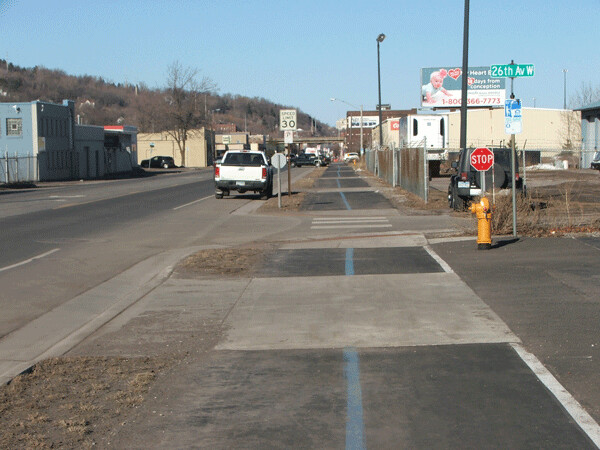
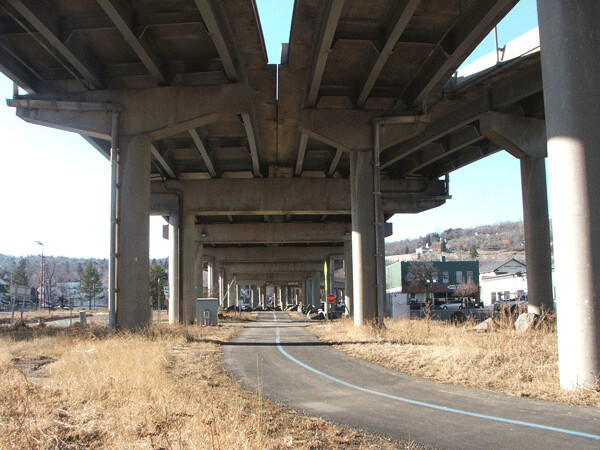
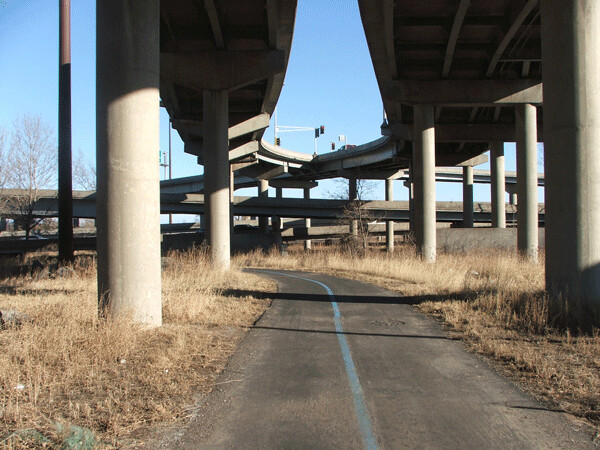
Cross City Trail
At the Parks Commission meeting of March 8, 2017, project coordinator Lisa Luokkala presented the Cross City Trail (CCT) Mini-Master Plan to commissioners. When complete, the CCT will be a wheelchair-accessible, approximately ten-mile-long blacktop path stretching from Canal Park to Spirit Mountain. The first segment, from Canal Park to Carlton Street, was built in 2014. Another segment, between Greene Street and the zoo, was completed in 2016. How to connect those two segments, which are essentially separated by West Duluth, has been a topic of much community discussion.
According to Luokkala, when citizens were presented with four alternatives for the missing segment in a survey, a majority of respondents favored the so-called “River Route,” which would start at Carlton Street and travel along the St. Louis River through areas of working industrial waterfront and pockets of urban forest to Irving Park in West Duluth. The reasons people liked this route were easy to understand: It was level, it didn’t cross many streets, and it provided a good look at a part of Duluth that most people only saw as they sped by on the freeway. The problem was that there were a lot of property owners along the way—six of them, including the state, the railroad, the paper mill and others. Surprisingly, though, according to Luokkala, the property issues had all been worked out.
“This segment is currently is full design and process,” she told commissioners. “We are anticipating construction of this segment in 2017 [and] completing it in 2018. This is moving quite quickly, and it’s very exciting that we’ve taken care of multiple property issues [and] trail easement issues on this segment, and are excited to proceed.”
Luokkala said the cost to build the three-mile River Route segment would be $1.6 million, which had already been secured. The funding is coming from a variety of sources, including state and federal grants and the city’s half-and-half tourism tax.
After Irving Park, the Mini-Master Plan arrives at what it calls “the least well-defined phase” of the CCT. One possibility would be to have the CCT cross busy Grand Avenue somewhere and travel up through Keene Creek Park to Greene Street, where it could connect with the trail segment that has already been paved to the zoo. This will involve a climb no matter what route is picked, and in many ways it will feel inefficient—for people who only want to travel east or west, the steep jaunt up to Greene Street will be completely unnecessary. If you were biking, it would be a much easier job to just keep pedaling down Grand than head up the hill.
Another possibility would be to have the CCT continue on the lower side of Grand Avenue, where it would follow an inactive railroad corridor to the Munger Trailhead at 72nd Avenue West. This so-called “Lower Route” would have almost no elevation change and would provide much more direct access to the zoo and points west. The problem is that there are quite a few road and railroad crossings to negotiate, and as with the River Route, ownership and easement issues need to be worked out. Staff and consultants are still studying the feasibility of the Lower Route.
The Lower Route is the alignment favored by the Friends of Western Duluth Parks and Trails, a volunteer group chaired by Mike Casey that has taken an interest in the project. During public comments, Casey praised city staff for completing the CCT plan, but he also told the commission, “We hope the focus stays [on the Lower Route] and it doesn’t relax. I would have liked to have seen a budget figure for those properties in the plan. I would have liked to have seen more emphasis on that.”
The Planning Commission unanimously approved the Cross City Trail Mini-Master Plan, to a scattered round of applause from the audience. Funding has yet to be secured for many remaining segments, each of which has its own challenges. The total cost of the 10.3-mile trail is estimated to be $9.5 million, but, as Mr. Casey noted, this does not include any land-acquisition costs. The price could easily go up. It may be several years before the trail is fully complete.
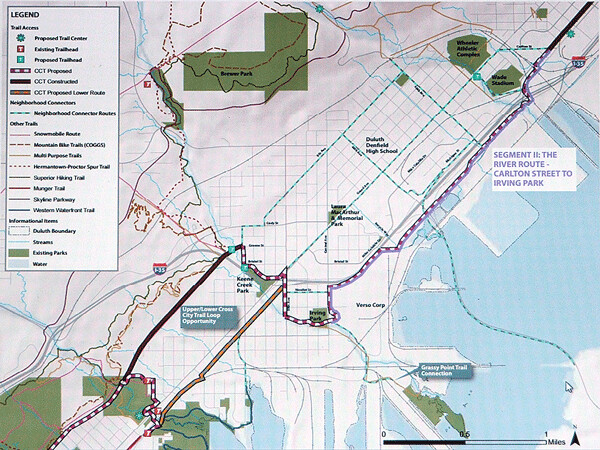
The Cross City Trail Mini-Master Plan may be found at www.duluthmn.gov/media/542042/3817-cross-city-trail-mmp-final-high-res.pdf
| Tweet |

